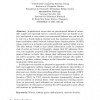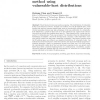12 search results - page 1 / 3 » Defending against hitlist worms using network address space ... |
CN
2007
13 years 4 months ago
2007
Worms are self-replicating malicious programs that represent a major security threat for the Internet, as they can infect and damage a large number of vulnerable hosts at timescal...
CMS
2006
13 years 6 months ago
2006
Abstract. Sophisticated worms that use precomputed hitlists of vulnerable targets are especially hard to contain, since they are harder to detect, and spread at rates where even au...
CCS
2006
ACM
13 years 8 months ago
2006
ACM
We give the first systematic investigation of the design space of worm defense system strategies. We accomplish this by g a taxonomy of defense strategies by abstracting away impl...
PADS
2005
ACM
13 years 10 months ago
2005
ACM
Most well-known Internet worms, such as Code Red, Slammer, and Blaster, infected vulnerable computers by scanning the entire Internet IPv4 space. In this paper, we present a new s...
IJSN
2007
13 years 4 months ago
2007
: Most Internet worms use random scanning. The distribution of vulnerable hosts on the Internet, however, is highly non-uniform over the IP-address space. This implies that random ...


